Recrystallisation and Trace-Element Mobility in Zircons: Implications for U-Pb Dating
Abstract
:1. Introduction
2. Geologic Background and Prior Sample Characterization
3. Materials and Methods
3.1. Sample Preparation
3.2. Electron Microscopy (CL, EBSD, FSE) & Microprobe (EMP)
4. Results
4.1. Zircon Morphology and Primary Structures
4.2. Recrystallisation Microstructures
4.3. Trace-Element Distributions across Recrystallisation Interfaces
5. Discussion
5.1. Current Models of Recrystallisation in Zircon
5.2. Proposed Hybrid Model
5.3. Implications for U-Pb Dating
6. Conclusions
- (1)
- Igneous zircons from the granitic injection complex of Harris on the island of Harris Lewis, Outer Hebrides, NW Scotland and the Jack Hills Metasedimetary Belt in the NW Yilgarn Craton of Western Australia show a variety of microstructures indicative of zircon recrystallisation. Recrystallisation of the zircons may range from a minor fading of the oscillatory zoning to a complete replacement of zoned by unzoned zircon;
- (2)
- We propose a new, hybrid model for zircon recrystallisation in these samples based on a combination of elements from previous models [1,10,12]. The fundamental mechanism responsible for recrystallisation within the studied zircons appears to be defect and trace element migration. The accumulation of dislocations in recrystallisation fronts yields a recrystallisation interface of minor misorientation (<2°). These recrystallisation interfaces may act as fast-diffusion pathways for trace-element diffusion. This mechanism results in a depletion of Y and an enrichment of Hf within the recrystallised zircon. After recrystallisation, metamictization may create fast diffusion pathways in the primary zircon due to fracturing. Recrystallisation and structural recovery of the metamict domain may also be accompanied by trace-element incorporation and leaching;
- (3)
- The heterogeneous distribution of trace elements has important implications for U-Pb dating. Different zones within a single zircon can yield varying U-Pb ages, suggesting that a detailed understanding of the crystallisation and recrystallisation history of the zircon is required to accurately interpret the U-Pb ages.
Author Contributions
Funding
Data Availability Statement
Acknowledgments
Conflicts of Interest
References
- Hoskin, P.W.; Black, L.P. Metamorphic zircon formation by solid-state recrystallization of protolith igneous zircon. J. Metamorph. Geol. 2000, 18, 423–439. [Google Scholar] [CrossRef]
- Pidgeon, R.T. Recrystallisation of oscillatory zoned zircon: Some geochronological and petrological implications. Contrib. Mineral. Petrol. 1992, 110, 463–472. [Google Scholar] [CrossRef]
- Pidgeon, R.T.; Nemchin, A.; Hitchen, G. Internal structures of zircons from Archaean granites from the Darling Range batholith: Implications for zircon stability and the interpretation of zircon U-Pb ages. Contrib. Mineral. Petrol. 1998, 132, 288–299. [Google Scholar] [CrossRef]
- Vonlanthen, P.; Fitz Gerald, J.D.; Rubatto, D.; Hermann, J. Recrystallization rims in zircon (Valle d’Arbedo, Switzerland): An integrated cathodoluminescence, LA-ICP-MS, SHRIMP, and TEM study. Am. Mineral. 2012, 97, 369–377. [Google Scholar] [CrossRef]
- Lee, J.K.; Williams, I.S.; Ellis, D.J. Pb, U and Th diffusion in natural zircon. Nature 1997, 390, 159–162. [Google Scholar] [CrossRef]
- Schaltegger, U.; Fanning, C.M.; Günther, D.; Maurin, J.C.; Schulmann, K.; Gebauer, D. Growth, annealing and recrystallization of zircon and preservation of monazite in high-grade metamorphism: Conventional and in-situ U-Pb isotope, cathodoluminescence and microchemical evidence. Contrib. Mineral. Petrol. 1999, 134, 186–201. [Google Scholar] [CrossRef]
- Vavra, G.; Schmid, R.; Gebauer, D. Internal morphology, habit and U-Th-Pb microanalysis of amphibolite-to-granulite facies zircons: Geochronology of the Ivrea Zone (Southern Alps). Contrib. Mineral. Petrol. 1999, 134, 380–404. [Google Scholar] [CrossRef]
- Soman, A.; Tomaschek, F.; Berndt, J.; Geisler, T.; Scherer, E. Hydrothermal reequilibration of zircon from an alkali pegmatite of Malawi. Beih. Eur. J. Mineral. 2006, 18, 132. [Google Scholar]
- Geisler, T. Isothermal annealing of partially metamict zircon: Evidence for a three-stage recovery process. Phys. Chem. Miner. 2002, 29, 420–429. [Google Scholar] [CrossRef]
- Geisler, T.; Schaltegger, U.; Tomaschek, F. Re-equilibration of zircon in aqueous fluids and melts. Elements 2007, 3, 43–50. [Google Scholar] [CrossRef]
- Geisler, T.; Pidgeon, R.T.; Kurtz, R.; Van Bronswijk, W.; Schleicher, H. Experimental hydrothermal alteration of partially metamict zircon. Am. Mineral. 2003, 88, 1496–1513. [Google Scholar] [CrossRef]
- Piazolo, S.; La Fontaine, A.; Trimby, P.; Harley, S.; Yang, L.; Armstrong, R.; Cairney, J.M. Deformation-induced trace element redistribution in zircon revealed using atom probe tomography. Nat. Commun. 2016, 7, 10490. [Google Scholar] [CrossRef] [PubMed] [Green Version]
- Reddy, S.M.; Timms, N.E.; Trimby, P.; Kinny, P.D.; Buchan, C.; Blake, K. Crystal-plastic deformation of zircon: A defect in the assumption of chemical robustness. Geology 2006, 34, 257–260. [Google Scholar] [CrossRef]
- Reddy, S.M.; Timms, N.E.; Hamilton, P.J.; Smyth, H.R. Deformation-related microstructures in magmatic zircon and implications for diffusion. Contrib. Mineral. Petrol. 2009, 157, 231–244. [Google Scholar] [CrossRef]
- Timms, N.E.; Kinny, P.D.; Reddy, S.M. Enhanced diffusion of uranium and thorium linked to crystal plasticity in zircon. Geochem. Trans. 2006, 7, 10. [Google Scholar] [CrossRef] [Green Version]
- Timms, N.E.; Kinny, P.D.; Reddy, S.M.; Evans, K.; Clark, C.; Healy, D. Relationship among titanium, rare earth elements, U–Pb ages and deformation microstructures in zircon: Implications for Ti-in-zircon thermometry. Chem. Geol. 2011, 280, 33–46. [Google Scholar] [CrossRef]
- Timms, N.E.; Reddy, S.M.; Gerald, J.D.F.; Green, L.; Muhling, J.R. Inclusion-localised crystal-plasticity, dynamic porosity, and fast-diffusion pathway generation in zircon. J. Struct. Geol. 2012, 35, 78–89. [Google Scholar] [CrossRef] [Green Version]
- Pidgeon, R.T.; Wilde, S.A. The interpretation of complex zircon u–pb systems in archaean granitoids and gneisses from the jack hills, narryer gneiss terrane, western australia. Precambrian Res. 1998, 91, 309–332. [Google Scholar] [CrossRef]
- Van Breemen, O.; Aftalion, M.; Pidgeon, R. The age of the granitic injection complex of Harris, Outer Hebrides. Scott. J. Geol. 1971, 7, 139–152. [Google Scholar] [CrossRef]
- Mortensen, J.K.; Card, K.D. U-Pb age constraints for the magmatic and tectonic evolution of the Pontiac Subprovince, Quebec. Can. J. Earth Sci. 1993, 30, 1970–1980. [Google Scholar] [CrossRef]
- Bickerton, L. Geological, Fluid-Chemical and Petrochronological Studies of the East Kemptville Sn (-Cu-Zn-Ag-In) Deposit and Its Devonian Host Batholith (Nova Scotia, Canada). Ph.D. Thesis, Laurentian University of Sudbury, Sudbury, ON, Canada, 2021. [Google Scholar]
- Kellett, D.A.; Muniz, P.I. Detrital U-Pb Zircon and 40Ar/39Ar Muscovite Geochronology of the Whitehorse trough, and Surrounding Rocks, Yukon and British Columbia; Geological Survey of Canada, Open File 8565; Natural Resources Canada, Geological Survey of Canada: Ottawa, ON, Canada, 2019. [Google Scholar]
- Black, L.P.; Kamo, S.L.; Allen, C.M.; Davis, D.W.; Aleinikoff, J.N.; Valley, J.W.; Mundil, R.; Campbell, I.H.; Korsch, R.J.; Williams, I.S.; et al. Improved 206Pb/238U microprobe geochronology by the monitoring of a trace-elementrelated matrix effect; SHRIMP, ID–TIMS, ELA–ICP–MS and oxygen isotope documentation for a series of zircon standards. Chem. Geol. 2004, 205, 115–140. [Google Scholar] [CrossRef]
- Stern, R.; Amelin, Y. Assessment of errors in SIMS zircon U–Pb geochronology using a natural zircon standard and NIST SRM 610 glass. Chem. Geol. 2003, 197, 111–142. [Google Scholar] [CrossRef]
- Stern, R.A. A New Isotopic and Trace-Element Standard for the Ion Microprobe: Preliminary Thermal Ionization Mass Spectrometry (TIMS) U-Pb and Electron-Microprobe Data; Natural Resources Canada, Geological Survey of Canada: Ottawa, ON, Canada, 2001. [Google Scholar]
- Lee, J.K.; Tromp, J. Self-induced fracture generation in zircon. J. Geophys. Res. Solid Earth 1995, 100, 17753–17770. [Google Scholar] [CrossRef]
- Nasdala, L.; Pidgeon, R.; Wolf, D.; Irmer, G. Metamictization and U-Pb isotopic discordance in single zircons: A combined Raman microprobe and SHRIMP ion probe study. Mineral. Petrol. 1998, 62, 1–27. [Google Scholar] [CrossRef]
- Colombini, L.L.; Miller, C.F.; Gualda, G.A.; Wooden, J.L.; Miller, J.S. Sphene and zircon in the Highland Range volcanic sequence (Miocene, southern Nevada, USA): Elemental partitioning, phase relations, and influence on evolution of silicic magma. Mineral. Petrol. 2011, 102, 29–50. [Google Scholar] [CrossRef]
- Linnen, R.L.; Keppler, H. Melt composition control of Zr/Hf fractionation in magmatic processes. Geochim. Cosmochim. Acta 2002, 66, 3293–3301. [Google Scholar] [CrossRef]
- Wang, X.; Griffin, W.L.; Chen, J. Hf contents and Zr/Hf ratios in granitic zircons. Geochem. J. 2010, 44, 65–72. [Google Scholar] [CrossRef] [Green Version]
- Tomaschek, F.; Kennedy, A.K.; Villa, I.M.; Lagos, M.; Ballhaus, C. Zircons from Syros, Cyclades, Greece—Recrystallization and mobilization of zircon during high-pressure metamorphism. J. Petrol. 2003, 44, 1977–2002. [Google Scholar] [CrossRef] [Green Version]
- Murakami, T.; Chakoumakos, B.C.; Ewing, R.C.; Lumpkin, G.R.; Weber, W.J. Alpha-decay event damage in zircon. Am. Mineral. 1991, 76, 1510–1532. [Google Scholar]
- Ge, R.; Wilde, S.A.; Nemchin, A.A.; Whitehouse, M.J.; Bellucci, J.J.; Erickson, T.M. Mechanisms and consequences of intra-crystalline enrichment of ancient radiogenic Pb in detrital Hadean zircons from the Jack Hills, Western Australia. Earth Planet. Sci. Lett. 2019, 517, 38–49. [Google Scholar] [CrossRef]
- Reddy, S.M.; van Riessen, A.; Saxey, D.W.; Johnson, T.E.; Rickard, W.D.; Fougerouse, D.; Fischer, S.; Prosa, T.J.; Rice, K.P.; Reinhard, D.A.; et al. Mechanisms of deformation-induced trace element migration in zircon resolved by atom probe and correlative microscopy. Geochim. Cosmochim. Acta 2016, 195, 158–170. [Google Scholar] [CrossRef] [Green Version]
- Peterman, E.M.; Reddy, S.M.; Saxey, D.W.; Fougerouse, D.; Snoeyenbos, D.; Rickard, W. Nanoscale processes of trace element mobility in metamorphosed zircon. Contrib. Mineral. Petrol. 2019, 174, 92. [Google Scholar] [CrossRef]
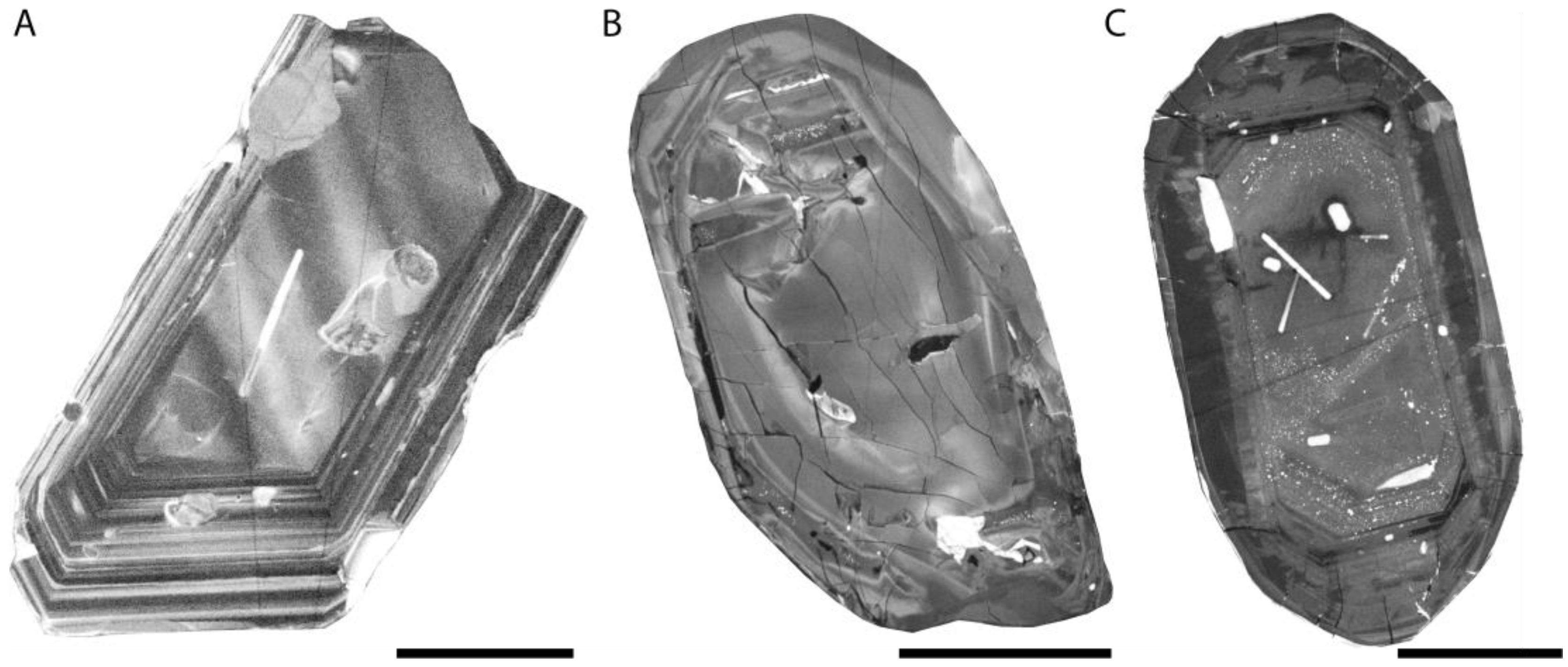

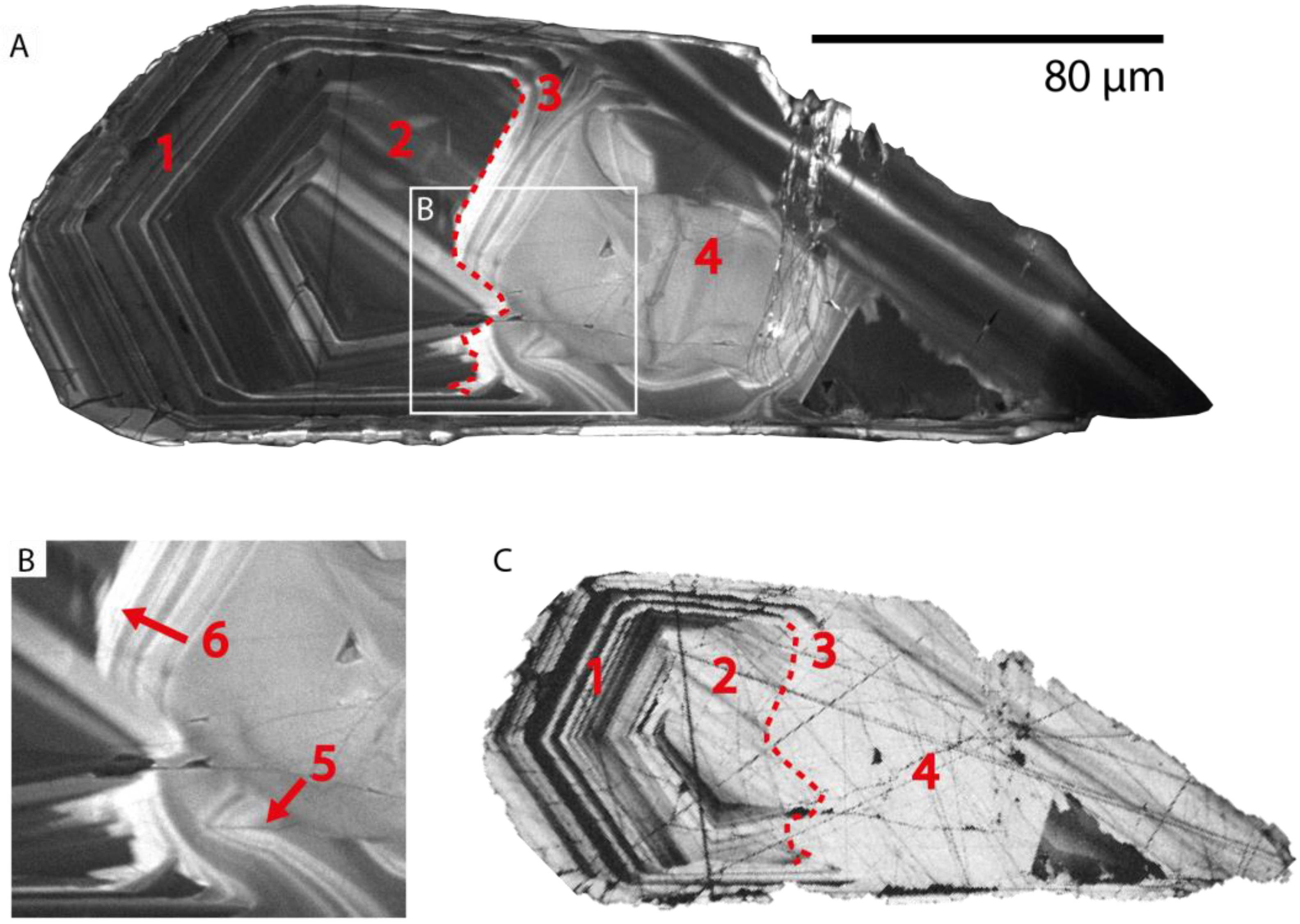
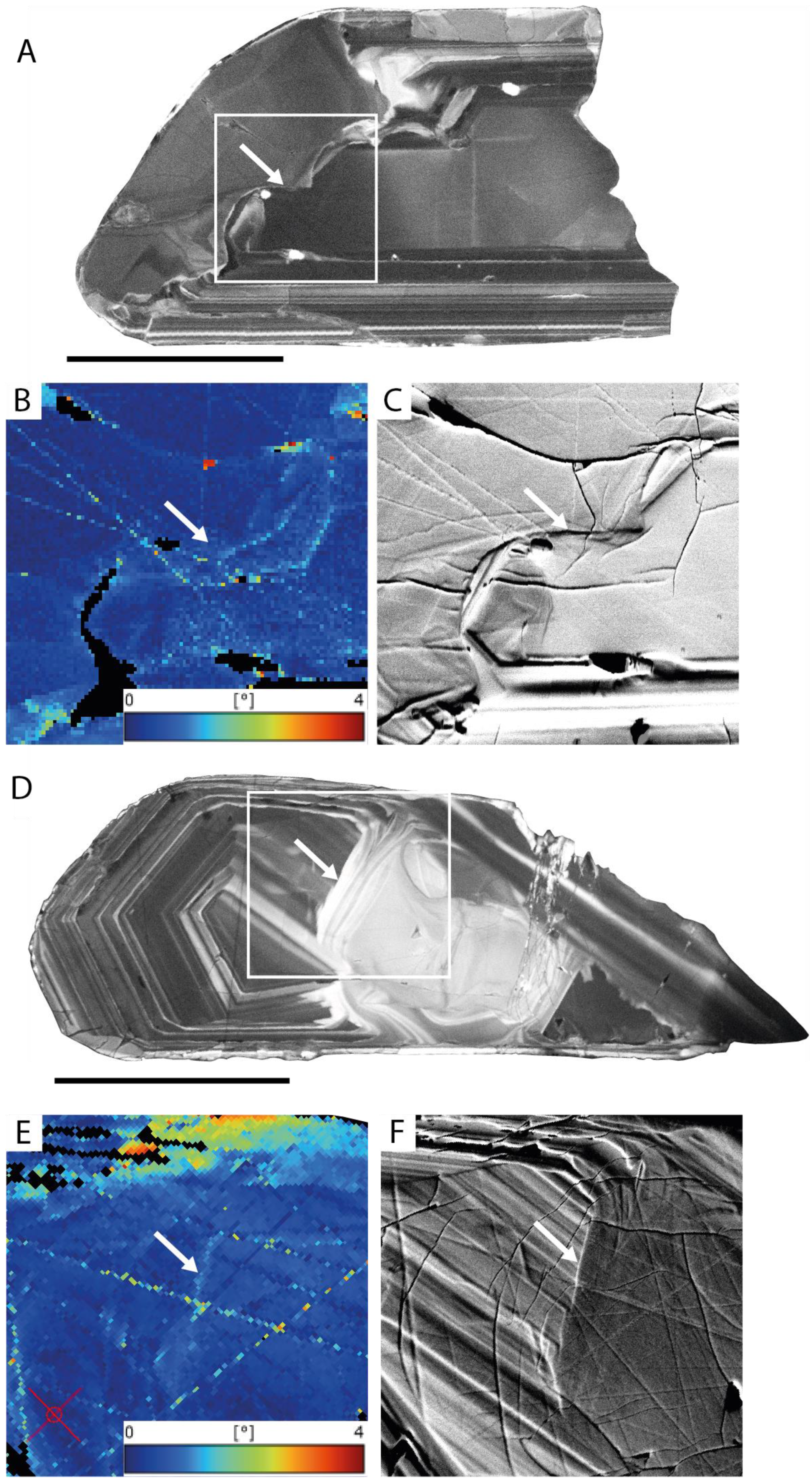
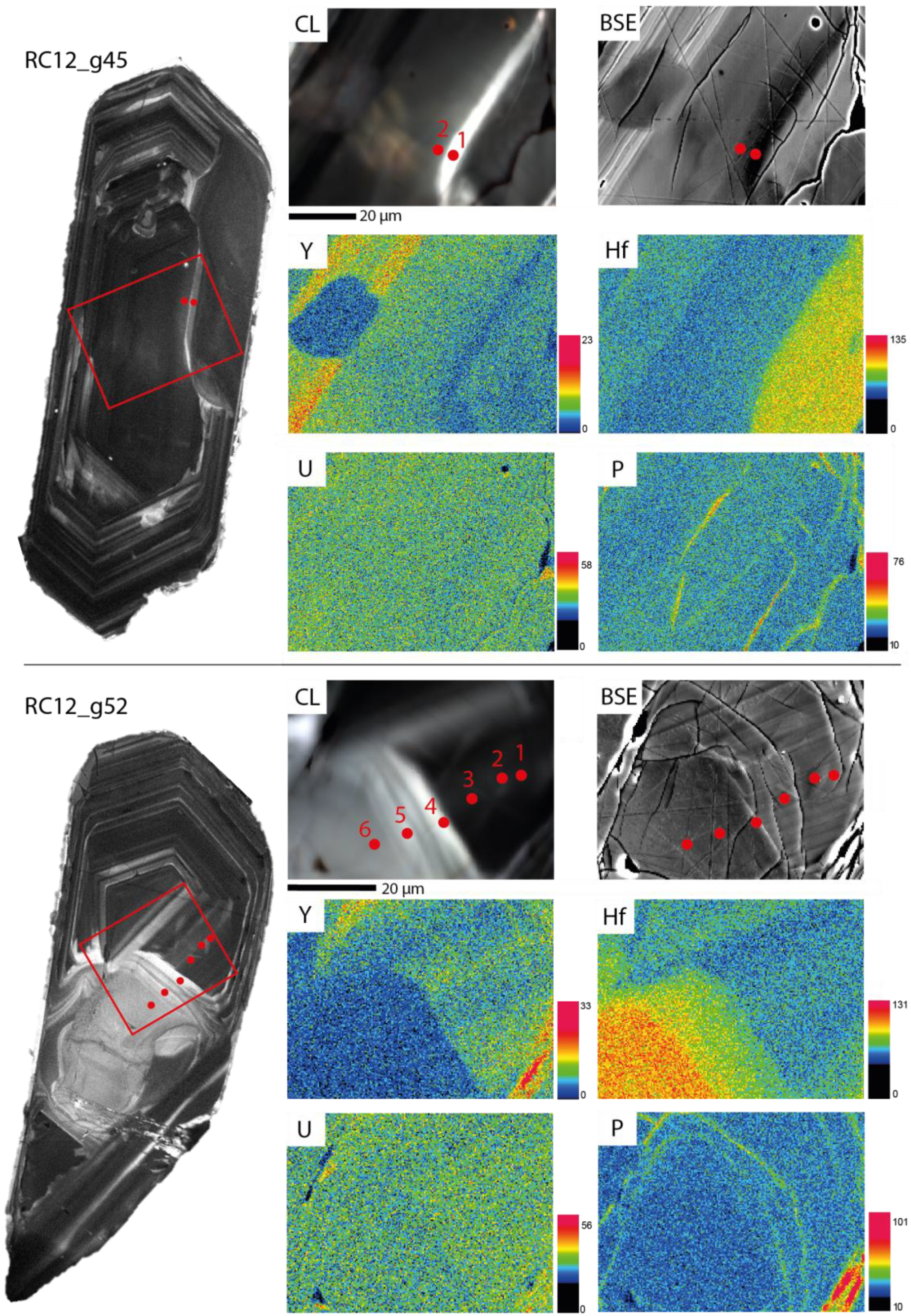
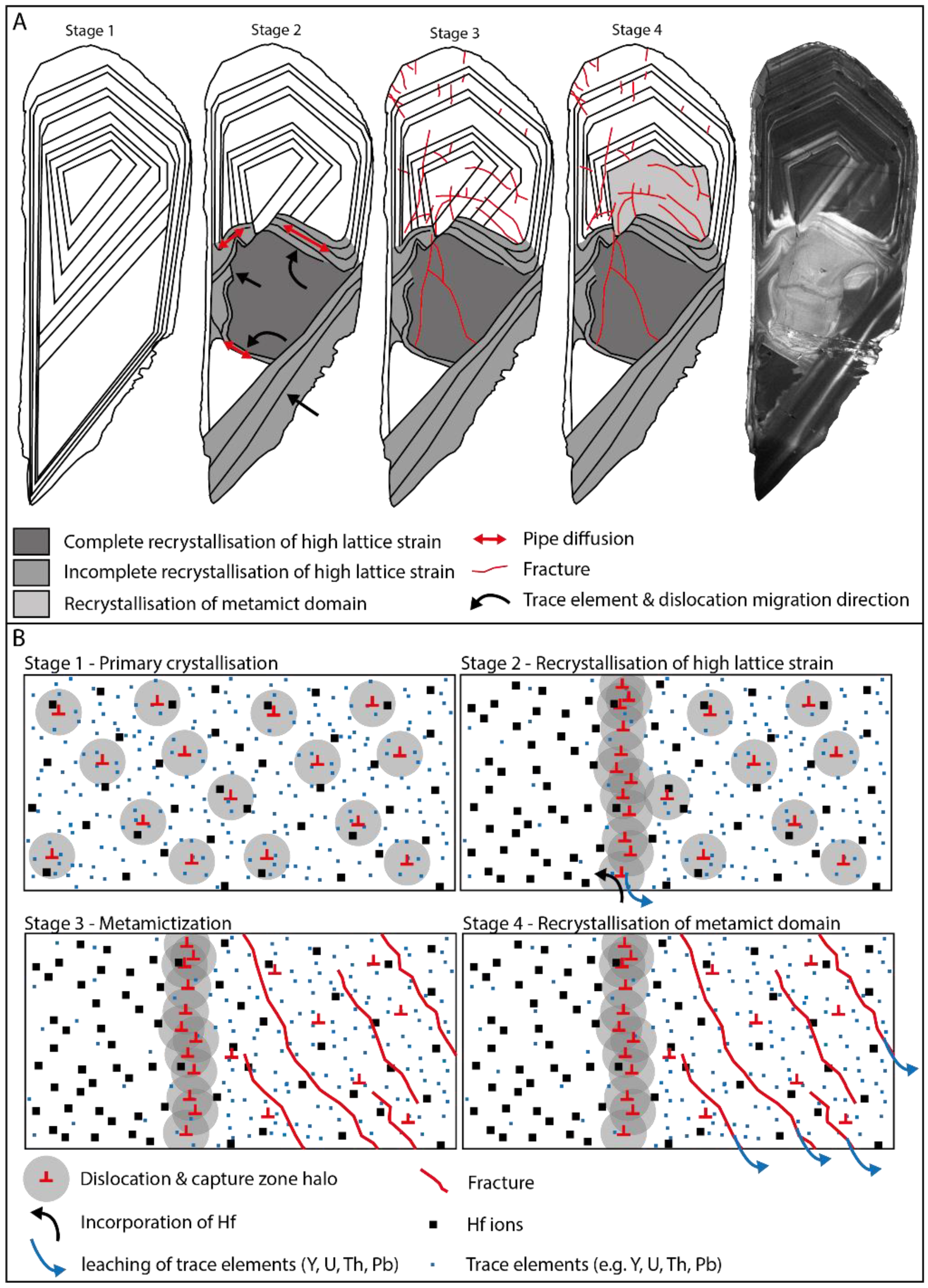
| RC12 | Spot | Hf (wt%) | U (ppm) | Th (ppm) | Y (ppm) |
|---|---|---|---|---|---|
| g45 | 1 | 1.55 ± 0.0002 | b.d.l | 454 ± 72 | 519 ± 25 |
| 2 | 1.76 ± 0.0002 | 759 ± 43 | b.d.l. | 1152 ± 13 | |
| g52 | 1 | 1.12 ± 0.0003 | 508 ± 64 | 869 ± 38 | 1641 ± 9 |
| 2 | 1.04 ± 0.0003 | 499 ± 64 | 466 ± 70 | 1322 ± 11 | |
| 3 | 1.09 ± 0.0003 | b.d.l. | b.d.l | 1550 ± 10 | |
| 4 | 1.34 ± 0.0002 | b.d.l. | b.d.l. | 247 ± 51 | |
| 5 | 1.58 ± 0.0002 | b.d.l. | b.d.l. | b.d.l. | |
| 6 | 2.13 ± 0.0002 | 616 ± 52 | b.d.l. | 350 ± 37 |
Publisher’s Note: MDPI stays neutral with regard to jurisdictional claims in published maps and institutional affiliations. |
© 2022 by the authors. Licensee MDPI, Basel, Switzerland. This article is an open access article distributed under the terms and conditions of the Creative Commons Attribution (CC BY) license (https://creativecommons.org/licenses/by/4.0/).
Share and Cite
Huijsmans, J.R.; Hamers, M.; Drury, M.R.; Lee, J.K.W. Recrystallisation and Trace-Element Mobility in Zircons: Implications for U-Pb Dating. Minerals 2022, 12, 1489. https://doi.org/10.3390/min12121489
Huijsmans JR, Hamers M, Drury MR, Lee JKW. Recrystallisation and Trace-Element Mobility in Zircons: Implications for U-Pb Dating. Minerals. 2022; 12(12):1489. https://doi.org/10.3390/min12121489
Chicago/Turabian StyleHuijsmans, Jasper R., Maartje Hamers, Martyn R. Drury, and James K. W. Lee. 2022. "Recrystallisation and Trace-Element Mobility in Zircons: Implications for U-Pb Dating" Minerals 12, no. 12: 1489. https://doi.org/10.3390/min12121489
APA StyleHuijsmans, J. R., Hamers, M., Drury, M. R., & Lee, J. K. W. (2022). Recrystallisation and Trace-Element Mobility in Zircons: Implications for U-Pb Dating. Minerals, 12(12), 1489. https://doi.org/10.3390/min12121489







